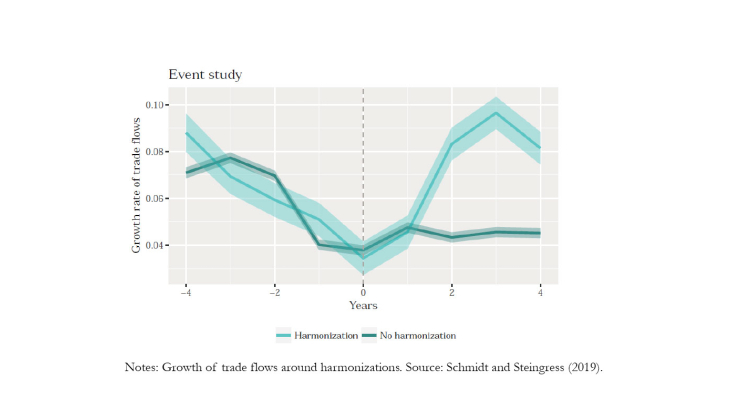Product standards are a defining feature of industrial processes and citizens’ everyday lives. From environmental or safety standards to technological standards that ensure the compatibility of different devices and inputs, standardization is widespread and affects production processes in virtually all industries. While standards assure a better synergy between inputs and products in a domestic context, they are among the first to be listed as barriers to trade. Cross-country standard harmonization can be an effective trade policy tool to reduce these non-tariff barriers, but its use is subject to debate in policy and academic circles alike.
Data limitations and econometric challenges have prevented a thorough assessment of the effects of product standards and their harmonization on international trade. The existing evidence concentrates on specific sectors and regulatory trade barriers such as sanitary and phytosanitary (SPS) measures. In addition, the literature has largely ignored the fact that most product standards are voluntary. This paper intends to fill this gap and analyzes the impact of standard harmonization on aggregate trade flows.
We track the accreditation of foreign and international standards at the document level and construct a novel bilateral product-level database of standard harmonization. Indeed, harmonized standard releases are omnipresent and concern more products than traditional barriers to trade. The extensive sectoral coverage of our dataset enables us to provide new evidence on the quantitative importance of standard harmonization.
To measure the impact on trade, we compare trade flows of harmonized versus non-harmonized products following a difference-in-difference approach. Our results show that, on average, standard harmonization increases product-level trade flows by 0.67%. This increase is driven by higher sales of existing varieties, while the positive contribution of more entry is minor. We further show that the increase in trade flows is a result of greater quantities being sold rather than a change in prices.
To translate our result into comparable economic outcomes, we compute ad-valorem tariff equivalents: that is, we ask what the hypothetical percentage point change is in the tariff rate that would yield the same effect as a harmonization event. We find that the impact of standard harmonization on trade flows corresponds to a tariff reduction of 2.1 percentage points. This marginal effect is amplified by the fact that over 40% of bilateral product-level trade flows are subject to standard harmonization every year. Overall, we estimate the average increase in world trade to be 0.27% per year, which is more than twice the contribution of tariff reductions.
To shed light on the underlying economic mechanisms, we build a multi-country model of heterogeneous firms and allow for endogenous standard adoption: i.e. firms decide to produce a standardized or a non-standardized variety of a differentiated product. Product standards capture product attributes, such as quality, safety or environmental aspects, which result in higher consumer demand. At the same time, producing standardized varieties requires sunk investment costs and higher marginal costs, which both increase with the severity of the standard. The presence of sunk costs implies a selection effect where only high-productivity firms are able to produce in accordance with the standard while low-productivity firms choose to produce the non-standardized variety.
Our results speak in favor of the presence of sunk investment costs and higher demand effects: standard harmonization gives firms the incentive to invest in the standard mainly by generating additional demand, such as through reducing information asymmetries and/or ensuring the compatibility of inputs and devices across markets.
